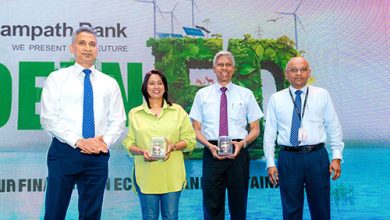SAMPATH BANK
Posts a PAT of Rs.11Bn for the first half of 2024, marking a YoY Increase of 45%
Financial Performance
Sampath Bank registered a profit before tax (PBT) of Rs 18.5 Bn and a profit after tax (PAT) of Rs 11.1 Bn for 1H 2024 reflecting growth rates of 40% and 45% respectively compared to the corresponding period of the previous year. The Sampath Group also reported PBT and PAT figures of Rs 19.7 Bn and Rs 11.9 Bn respectively, reflecting growth rates of 47% and 55%.
Key Financial Highlights for 1H 2024
- 3%growth in Net Interest Income (NII).
- Decrease in net fee and commission income by10.9% due to a decline in income from trade- related operations.
- Anex change loss of Rs.2.7Bn due to the appreciation of the LKR against the USD by Rs.17.85.
- 6 % decline in impairment charges.
- Growth in LKR loan book by Rs.33Bn.
- Strong growth in the LKR deposit portfolio, amounting to Rs.115Bn.
- Tier 1 and Total Capital Adequacy Ratios at 16.98% and 19.96% respectively, comfortably exceeding regulatory minimum requirements.
Fund Based Income
During the first half of 2024, the Bank reported a total interest income of Rs 95 Bn, a 5.7% decline from the same period of the previous year, primarily attributable to a decreasing AWPLR. The continuous decline in market interest rates resulted in the interest expense for the period decreasing from Rs 67 Bn in 1H 2023 to Rs 54 Bn in 1H 2024. This substantial decrease in interest expense, outpacing the decline in interest income, resulted in a notable 20.3% increase in Net Interest Income (NII), reaching Rs 41 Bn for 1H 2024.
The Bank’s strategic management of assets and liabilities significantly contributed to the impressive growth in Net Interest Income (NII), particularly in the context of declining interest rates. The Net Interest Margin (NIM) experienced a slight increase, rising from 5.16% as of 31st December 2023, to 5.18% as of the reporting date.
Non-Fund Based Income
In 1H 2024, the Bank’s Net fee and commission income amounted to Rs 8.7 Bn, reflecting a 11% decline compared to the previous period, primarily due to reduced income from trade-related activities. The decrease in trade-related income is mainly attributed to reduced commission rates on import transactions and the impact of LKR appreciation. However, fees generated from other channels, including credit, electronic, cards and remittance-related activities, showed growth compared to the same period of the previous year.
In 1H 2024, the Bank reported a net trading loss of Rs 2.4 Bn, compared to a gain of Rs 1.7 Bn in the previous period. This was primarily due to revaluation losses incurred on forward exchange contracts. Conversely, Net other operating income for the period stood at Rs 151 Mn, a significant improvement compared to the loss of Rs 5.1 Bn in the previous period. This improvement was largely driven by a decrease in exchange losses as the LKR appreciated at a lower rate of 5.5% during the reporting period, compared to a 15.8% appreciation in 1H 2023.
Impairment Charge
The Bank recorded a total impairment charge of Rs 6.2 Bn for the first half of 2024, 14.6% less than the charge for the 1H 2023. Of this total, Rs 3.7 Bn was attributed to loans and advances (1H 2023: Rs 8.7 Bn), while Rs 1.0 Bn was related to other financial instruments (1H 2023: a reversal of Rs 1.4 2 Bn). Additionally, an impairment charge of Rs 1.5 Bn was recorded against credit-related commitments and contingencies (1H 2023: a reversal of Rs 66 Mn).
Impairment Charge on Loans and Advances
During the reporting period, the Bank experienced a 58% decrease in the impairment charge on loans and advances. This improvement reflects the prudent provisioning policies applied in previous years, as well as the resurgence of economic activities, which has enhanced the repayment capacity of the customers. The Bank, through its Business Revival Unit, continued to extend support to stressed borrowers by providing a range of measures to assist and revive businesses. These measures are customized based on the circumstances leading to their situation, as well as the industries and markets in which they operate. This support has benefited and continues to benefit many borrowers by helping them revitalize their businesses and improve their credit profiles.
As of 30th June 2024, the Bank conducted an extensive evaluation of its individually significant customers (ISL) and allocated adequate provisions in the Financial Statements to address the unique risk profiles associated with each of these customers. During the reporting period, the Bank reported a reversal in collective impairment, reflecting the economic revival of the country and the consequent enhancements in customers’ credit quality. Despite the substantial progress observed in the tourism sector, the Bank continues to categorize facilities within this sector as elevated risk under Stage 2 until full stabilization is achieved. Furthermore, the Bank continued to maintain allowances for overlays for customer segments still carrying an increased credit risk. The basic impairment models used for collective impairment in 2023 remained unchanged, ensuring sufficient buffers to mitigate potential future credit risks.
Impairment Charge on other Financial Instruments
The Bank recorded a net impairment charge of Rs 1.0 Bn against other financial instruments during the period, primarily due to the recognition of an additional charge against Sri Lanka International Sovereign Bonds (SLISB) in 1Q 2024. Given the government’s announcement on the updated terms for the restructured SLISBs, we are confident that there is no need to recognise additional charges, as the Bank has sufficiently provided for all anticipated losses and contingencies.
Operating Expenses
During the reporting period, operating expenses increased by 11.2% compared to the corresponding period in 2023. The rise in personnel costs by 22.5% was primarily due to annual salary increments. The Bank’s cost-to-income ratio improved by 230 basis points, decreasing from 39.8% in 1H 2023 to 37.5% in 1H 2024. This improvement can be attributed to growth in operating income outpacing the increase in operating expenses during the period.
Taxation
The Bank’s total effective tax rate decreased to 53.8% in the first half of 2024, down from 55.9% reported in the corresponding period in 2023.
Key Ratios
As of 30th June 2024, the Return on Average Shareholders’ Equity (after tax) increased to 14.9%, up from 12.7% as of 31st December 2023. Similarly, the Return on Average Assets (before tax) stood at 2.3% as of 30th June 2024, compared to 2.1% reported at the end of 2023.
Capital and Liquidity
During the reporting period, Sampath Bank maintained all its capital and liquidity ratios comfortably above regulatory minimum requirements. As of 30th June 2024, the Bank’s CET 1, Tier 1, and Total capital ratios were 16.98%, 16.98%, and 19.96%, respectively, compared to 16.35%, 16.35%, and 19.56% at the end of 2023.
Similarly, the Bank’s liquidity levels remained robust and comfortably above regulatory minimum 3 requirements, with all currency Liquidity Coverage Ratio at 299.48% and Net Stable Funding Ratio at 195.48% as at 30th June 2024, compared to 312.47% and 184.20% at the end of 2023.
Assets
As of 30th June 2024, the Bank’s asset base expanded by 6.4%, representing an annualized growth of 12.9%, reaching Rs 1.64 Tn. This growth was fueled by increased investments in Government debt securities and the expansion of the loan portfolio. Investments in LKR T-bonds increased by Rs 116 Bn, while holdings in US Treasuries grew by Rs 22 Bn (equivalent to USD 78 Mn) during the period. Total gross loans increased by Rs 31 Bn, from Rs 877 Bn as of 31st December 2023 to Rs 908 Bn by the end of June 2024. LKR-denominated loans increased by Rs 33 Bn, while foreign currency loans declined by Rs 2 Bn due to the appreciation of the LKR against the USD during the period.
Liabilities
Total liabilities increased by 6.7% (annualized growth of 13.5%), primarily due to the expansion of the Bank’s total deposit portfolio by Rs 89 Bn, from Rs 1,264.5 Bn at the end of 2023 to Rs 1,353.2 Bn as of 30th June 2024. LKR deposits grew by Rs 115 Bn, while FCY deposits decreased by Rs 26 Bn during the period. The CASA ratio stood at 33.1% at the end of 1H 2024, slightly lower than the 33.4% reported at the end of 2023.
External Rating
On 22nd July 2024, Fitch Ratings Lanka Limited affirmed Sampath Bank’s National Long-Term Rating at “A(lka)” with a Stable outlook. Fitch also affirmed the “BBB+(lka)” rating for the Bank’s outstanding Basel III compliant subordinated debentures.







